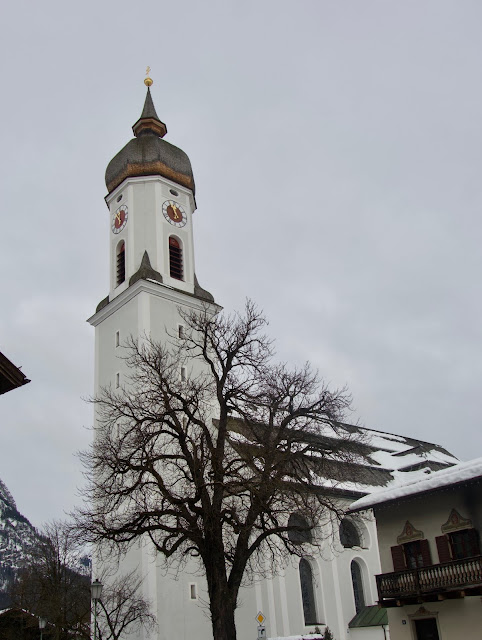 |
| Zugspitze |
Bavaria: A Quick Glance
As I write this, I’m in the heart of Bavaria, and for those of you who don’t know, Bavaria is the deep south of Germany, but unlike the deep south of the United States, Bavaria is snow country, the place you come to shovel snow and scrape your windshield and participate in every winter sport imaginable.
Dress warmly, or suffer in the presence of a temperature gauge that hovers below freezing and tumbles down a few degrees when the sun goes down.
Alpine summers can also be a wonderland, with mountain caps still blessed with white, while scantily clad walkers and hikers and bicyclers suck in the mountain air and sweat the trails, high and low.
Even in winter, the natives are outdoor people who thrive on ski slopes and also flat, Nordic (cross country) ski trails. Not unusual to see eighty year olds coming off the slopes, stacking their skis and doffing their ski parkas to stand in ankle deep snow in steaming t-shirts and sipping liter mugs of ice cold beer. Saying ‘hardy’ barely covers the territory.
Let’s talk about the world famous mountain range, the Alps. Check out this map and save me the trouble of writing several thousand words. But, verbose fellow that I am, I will add some comments. Note there are French Alps and Italian Alps and German Alps and Austrian Alps and of course the Swiss Alps. The area is home to about fourteen million people, with yearly visitors numbering over 120 million.
Being a curious soul (just ask anyone who’s seen me crouch down and watch meandering ants until my joints ached) I wondered where the name Alps came from. Well, take your pick! Latin, albus means white. In modern languages, alp or alpe refers to grazing pastures and there are plenty of cows here. Or maybe you prefer the Celtic or Italo-Celtic derivation: alp, meaning mountains of snow where the mentally deranged grab flat boards and speed down steep slopes in search of death. Unable to complete their quest on the first try, they do it again and again, slaking their thirst with kegs of brew.
But, you can’t mention Bavaria and The Alps without mentioned the Zugspitze, at a bit over 2900 m (9700 ft), it’s the highest mountain in the Wetterstein Mountains, the portion of the Alps that goes from Garmisch-Partenkirchen into the Austrian Tyrol. The Zugspitze is also the highest mountain in Germany. Three cable cars will get you to the top.
Have a yen to ski Austria? Slopes are only 30 minutes away.
 |
| Ettal Abby |
Anything other than ski and snowboard around here? Yes, of course. Near Garmisch-Partenkirchen sits the Ettal Abby, a huge, high walled community, where the monks still brew beer and other potables, while tourists stand and marvel. Then there’s the famous Neuschwanstein Castle, which inspired the Disneyland Castle, and the jewel-like Linderhof Palace, both of which were built by King Ludwig II of Bavaria (1845-1886)
 |
| Linderhof Palace |
One interesting thing about Ludwig was his quest for privacy. At the Linderhof Palace (in many ways modeled after Louis XIV’s Palace at Versaille) the dining room is special. The dining table can be lowered through the floor to the kitchen, where the staff loaded the meal, then raised the table up to the dining room again. Yes ‘dining alone’ was taken to extremes, but Ludwig had many quirks. He never married, had no children, and preferred the company of men. Homosexuality was not a crime in Bavaria at the time, but Ludwig was also a strong Roman Catholic and apparently for his whole life he fought the battle of personal urges versus religious piety.
 |
| King Ludwig II of Bavaria |
Another wonderful place to visit is the nearby Partnachlamm, a deep and narrow gorge spanning the Partnach River. Pay your entry fee and stroll a narrow stone path through short hewn caves. The river winds through a mouthain crevace. Along the way you’ll see magical ice formations you’ve never imagined that rise in massive splendor from the shallow, flowing river up the vertical cliffs.
Garmisch-Partenkirchen, the town where we stayed is a story-book village of giant wood beamed houses and businesses whose fronts display Bavarian hunting and skiing scenes.
 |
| Pharmacy, Bavarian Version |
Bavaria is a world unto itself. The mouthains rival anything in Switzerland and the people still wear wool and leader clothing that immiately identify them as Bavarians. You won’t hear “Guten Tag!” here as you do in the rest of Germany, but “Grüß Gott!” You’ll also hear this greeting in Austria, but languages evolve and with the younger generations, you’re more than likely to hear a simple “Hallo!”
Bavaria truly is a wonderland, winter or summer, skier or not. The magestic peaks rise like ancient gods that own the land. And Bavarians are a warm and welcoming people.
In the next installment of ‘Follow Stroud Around the Globe,” I’ll tell you a little something about Bavarian cuisine. But, first a few more photos of this glorious place, where every snapshot is worthy of a travel poster.














